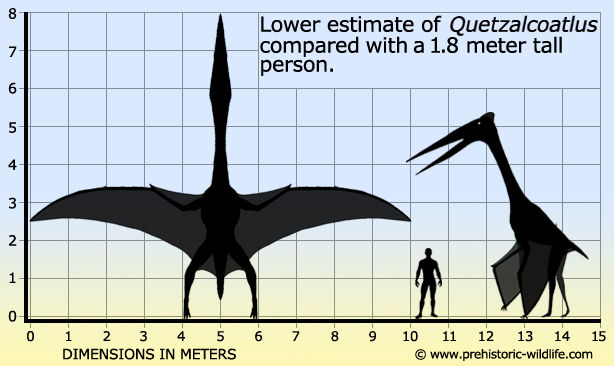
CREATURE-PEDIA
Fun Fact
With a 36 to 40 feet wingspan, this huge pterosaur was one of the largest flying creature that ever took to the sky.
Quetzalcoatlus




Quetzalcoatlus was a pterosaur known from the Late Cretaceous of North America (Maastrichtian stage) and the largest known member of the Azhdarchidae, a family of advanced toothless pterosaurs with unusually long, stiffened necks. Its name comes from the Mesoamerican feathered serpent Quetzalcoatl. At up to 16 feet tall, these massive pterosaurs could stand nearly 3x taller than a human, tall enough to look in a giraffe in the eye, their front limbs were also vast wings that when unfold, it can stretch up to 36 to 40 feet across, the same length of a modern learjet, it also had a beak up to 5 feet long perfectly suited for preying off on other animals. Because the area of the fossil site was four hundred kilometers removed from the coastline and there were no indications of large rivers or deep lakes nearby at the end of the Cretaceous, Lawson in 1975 rejected a fish-eating lifestyle, instead suggesting that Quetzalcoatlus scavenged like the marabou stork, but then on the carcasses of titanosaur sauropods such as Alamosaurus. The model successfully flew with a combination of soaring and wing flapping, however, the model was half scale based on a then-current weight estimate of around 80 kg, far lower than more modern estimates of over 200 kg. The method of flight in these pterosaurs depends largely on weight, which has been controversial, and widely differing masses have been favored by different scientists. Some researchers have suggested that these animals employed slow, soaring flight, while others have concluded that their flight was fast and dynamic. In 2010, Donald Henderson argued that the mass of Quetzalcoatlus had been underestimated, even the highest estimates, and that it was too massive to have achieved powered flight. He estimated it in his 2010 paper as 540 kg. Henderson argued that it may have been flightless. Some believe that large pterosaurs most likely utilized a short burst of powered flight in order to then transition to thermal soaring.

